Based on HR statistics, organizations can use data on human resources to adjust, learn, and make better decisions.
Human resources are an important department in any business and organization. And with the right knowledge of which challenges there are, HR can help in giving employees a positive experience at work.
Read on to find out about HR industry statistics, as well as statistics on HR management, HR automation, HR technology, and more.
Here is what you can learn about:
- Human Resources Industry Statistics
- Human Resource Management Statistics
- HR Automation Statistics
- HR Analytics Statistics
- HR Technology Statistics
- HR Statistics UK
- Interesting Human Resources Statistics
Key Statistics For HR (Editor’s Pick)
- The global human resources industry has a value of $356 billion in 2010.
- 47% of HR teams say their biggest challenge is employee retention.
- In the next few years, 53% of HR departments expect to invest in AI.
- 76% of recruiters save time with the help of AI.
- 60% of companies hope to invest more in people analytics.
- In the US, 80% of small businesses use or plan to use HR software.
- 75% of companies already use the cloud.
- The UK HR market size is valued at £978 million.
- 75% of employers reject applications with typos and bad grammar.
Human Resources Industry Statistics
1. In 2010, the global HR industry market exceeded the value of $356 billion.
The HR industry exceeded the value of $356 billion in 2010, according to MarketLine. Moreover, it was expected to have an annual growth rate of 5% between 2010 and 2015. By then, the market was expected to exceed $454 billion.
Source: MarketLine
2. In 2020, the human resource management industry was valued at $17.56 billion.
The global human resource market was estimated at a value of $17.56 billion in 2020, according to Grand View Research HR stats. Furthermore, automation and digitization of HR operations will help the market grow in the future, too.
Source: Grand View Research
3. The global human resources market is expected to grow at an annual rate of 12.2% from 2021 to 2028.
According to Grand View Research, the global HR market will grow at a compound annual growth rate of 12.2% between 2021 and 2028. Moreover, this growth is possible thanks to the fact companies are retaining talent, attracting the right pool of candidates, and effectively managing their resources.
Source: Grand View Research
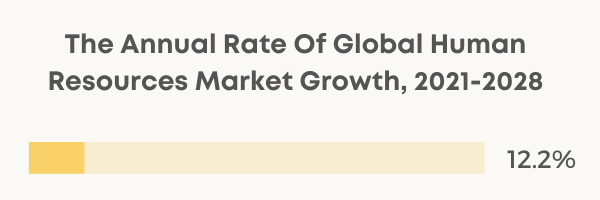

4. The software component of the HR market had a revenue share of 68%.
Thanks to the available data on human resource industry statistics, we know that the software component of human resources dominated the market. It had a revenue share of 68%. Also, this is because many companies are turning to HR and talent management software and programs while trying to retain talent.
Source: Grand View Research
5. Since 2016, the demand for recruiting professionals has jumped by 63%.
According to a LinkedIn report from 2019, the demand for recruiting professionals has jumped by 63% since 2016. Moreover, the number was expected to grow in the future, too.
Source: LinkedIn
6. By 2025, the HR software market is supposed to be valued at $30 billion.
In the next four years, we could see the HR software market grow to a value of over $30 billion, according to Grand View Research HR data statistics. Moreover, that is a growth of 9.4% by 2025. Other estimations suggest that the market will pass $10 billion in value by 2022.
Source: Grand View Research
Human Resource Management Statistics
7. Under half (47%) HR teams say their biggest challenge is employee retention and turnover.
According to a report from Work Institute in 2019, almost half of HR teams (47%) say they have the biggest problems with retaining employees and employee turnover. Also, in the top three challenges, there is recruitment and corporate culture management that HR teams struggle with.
Source: Work Institute Retention Report 2019
8. The HR management market has a value of $19.38 billion in 2021.
In 2021, the human resources management market had a value of $19.28 billion. Moreover, by 2028, the human resources management market is estimated to have a revenue of $43.29 billion.
Source: Grand View Research
9. 55% of executives expect their workers to work from home one day a week.
When managing employees after the pandemic, 55% of HR executives plan to have their workers working from home one day a week. In comparison, before the pandemic, only 39% of executives planned to have their workers working from home one day every week.
Source: PwC
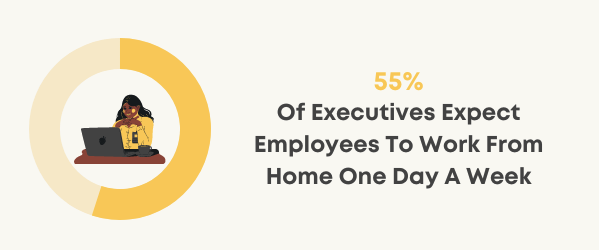

10. After the pandemic, 32% of workers want to continue working from home five days a week.
Once the pandemic dies down and things go back to normal, one in three workers (32%) still wants to continue working from home five days a week. Moreover, 9% want to do it four days a week, 17% three days a week, 14% two days a week, and 11% one day a week. Finally, only 17% want to work in the office full-time or most time.
Source: PwC
11. Almost nine in 10 employees take part in lifestyle management programs.
Lifestyle management programs include programs that focus on smoking and obesity. Such programs see a participation rate of around 87% of employees. At the same time, on average, these programs saved employees around $6 per month, while saving employers $0.5 a month.
Source: Rand Corporation
HR Automation Statistics
12. By 2022, 47% of organizations will utilize AI-based solutions in HR.
When it comes to automation and artificial intelligence in human resources, by 2022, 47% of companies will use AI-based solutions for HR. Moreover, 17% of business companies already leverage these types of solutions.
Source: Gartner
13. Out of those who use AI in HR, 57% use it to enhance employee experience.
While HR automation makes money for the companies, it can also help improve the employee experience. How? Well, with automation doing the repetitive tasks, employees can focus on doing more engaging work. That is why 57% of companies who use AI, influence employee experience.
Source: Gartner
14. As a problem for automation, 36% of HR professionals blame insufficient technology.
When it comes to automating and improving the onboarding process of the company, 36% of HR professionals blame insufficient technology as a reason they cannot educate and train managers for proper onboarding strategies.
Source: Kronos
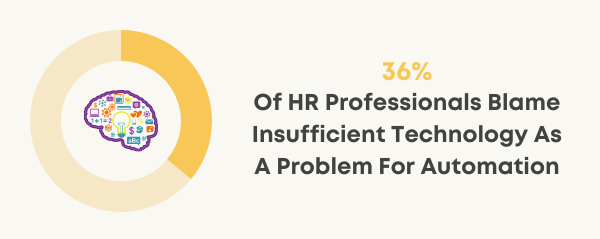

15. More than half (53%) of HR departments expect to invest in automation in the next few years.
According to HR automation statistics from 2019, 53% of HR departments are expected to invest in automation in the next few years. This estimate is based on interviews with 1200 professionals.
Source: KPMG
16. Almost eight in 10 recruiters (76%) believe that artificial intelligence will play a key role in HR in the upcoming years.
If anyone needs a reason to invest in artificial intelligence in human resources, here is one. Around 76% of recruiters in 2019 said they believe that it will play a huge role in HR in the next few years.
Source: KPMG
17. Before 2019, only 14% of HR departments have invested in AI.
While everyone admits AI will play a vital role in the future of HR, not many have dared to implement it into their company and invest in it. According to KPMG data from 2019, only 14% of HR departments have already invested in it. Moreover, only 36% of HR functions have started introducing it. Out of those, 88% say the investment was worth it.
Source: KPMG
18. 76% of recruiters save time with the help of AI, 31% bring best match candidates, and 30% save a lot of money.
According to DevSkiller, there are many benefits of having automation included in HR processes. For instance, out of those who use AI, 76% of recruiters say it saves them time, 31% say it brings them the best candidate matches, and 30% say they save a lot of money.
Source: DevSkiller
19. More than half of companies (51%) utilize AI to save costs in HR.
While artificial intelligence can help companies automate repetitive tasks, this can help human resources save money. According to Gartner, 51% of companies utilize artificial intelligence to save costs.
Source: Gartner


HR Analytics Statistics
20. More than eight in 10 HR professionals believe people analytics will play a significant role in the future.
For the future of human resources and the success of companies, 85% of HR professionals believe that people analytics will play a significant role. While the world average is 85%, 92% of Indian talent professionals think the same. Moreover, so do 90% of South Asian HR professionals.
Source: LinkedIn
21. To measure and improve performance in HR operations, 72% of HR professionals already use people analytics.
While the large majority believe people analytics will be very important for the future of human resources, HR analytics statistics also show that many are already utilizing them. For instance, according to a report from LinkedIn, 72% of HR professionals are already using people analytics to measure and improve their performance.
Source: LinkedIn
22. Barely one in three HR executives are very confident about transforming the workforce with AI and analytics.
According to a 2019 report from KPMG, only 37% of HR executives say they are very confident they can transform the workforce with the help of artificial intelligence and analytics. However, two-thirds of HR executives do agree that the workforce is undergoing a digital transformation.
Source: KPMG
23. Only one in five HR leaders agree their primary HR initiative over the next couple of years will be analytics.
In 2019, only 20% of HR leaders believed they would focus on analytics as their primary HR initiative over the next few years. Furthermore, only 12% said their top management concern is analytics.
Source: KPMG
24. In 2019, six in 10 HR leaders planned to invest more in predictive analytics over the next two years.
When asked about investments in predictive analytics, 60% of HR leaders said they would invest more in it over the next few years. Moreover, 53% and 47% said they would invest in enhanced process automation and AI respectively.
Source: KPMG


25. Only 5% of organizations believe they are effective in using and tracking talent analytics.
Before becoming Gartner, CEB Global researched trends from HR leaders in 2016. As it turns out, only 5% of organizations use talent analytics effectively, while it has massive potential. Furthermore, only 12% of HR organizations use predictive analytics for talent decision-making. Also, 49% hope to do so in the future.
Source: CEB Global/Gartner
26. 58% of HR leaders need improved HR analytics for choosing high potential and identifying future leaders.
Almost six in 10 HR leaders (58%) say they need improved HR analytics mostly to be able to choose high potential and identify future leaders, according to HR and leadership statistics.
Source: CEB Global/Gartner
HR Technology Statistics
27. 58% of business companies use HR technology to find, retain, and attract talent.
According to a PwC survey on HR technology statistics, 58% of companies use HR technologies to attract, find, and retain talent. As digital systems replaced hiring processes based on paper, HR technology even managed to automate some of the hiring talent processes.
Source: PwC
28. Around 44% of talent leaders use the cloud to maximize efficacy and productivity, while 35% use it to reduce costs.
According to the PwC survey from 2020, 44% of HR professionals say they use cloud technologies to help them boost productivity, while 35% it is a way for them to reduce costs.
Source: PwC
29. More than seven in 10 HR leaders (74%) plan to increase investments in HR technologies.
When it comes to spending more money on HR technologies, 74% of HR professionals say they see their spending on HR technologies increasing. Thanks to the human resources management system, the savings allow HR leaders to invest more money in HR technologies.
Source: PwC
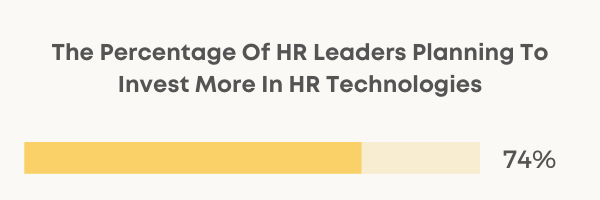

30. Through 2022, HR technology will focus on tools for talent acquisition (49%) and employee experience (48%).
While HR technologies can be used for many different things, 49% of organizations will focus on using them for talent acquisition. Moreover, 48% will focus on employee experience with the help of it. This data is according to 594 HR and HR IT leaders who answered a survey in 2020.
Source: PwC
31. In the US, 79% of HR professionals believe their companies have the technology needed for the changing work environment.
When it comes to the changing work environment, technology can help to keep companies in the loop. Luckily, in the US, 79% of HR professionals believe their companies have the needed technology to keep up with the ever-changing work environment.
Source: SHRM
32. Due to the pandemic, remote collaboration is the top technology investment for companies.
When it comes to the outbreak of the COVID-19 pandemic, remote work has become the norm. Moreover, according to an SHRM report from 2020, remote collaboration is the top technology investment for companies that want their employees to continue working from home amid the pandemic.
Source: SHRM
33. When it comes to recruiting challenges, 26% of organizations say the most difficult one is ineffective recruiting technology.
Around one-quarter (26%) of companies say their most difficult recruiting challenge is recruiting technology. They describe this technology as ineffective to help in recruiting talent, according to a Deloitte 2019 report.
Source: Deloitte
34. Only 6% of recruitment organizations believe they have the best technology and processes.
According to a survey on HR technology in 2019, only 6% of companies who recruit believe they have the best-needed technologies for their business. This data is concerning, as technologies can be of a lot of help for recruiting companies. Moreover, only 12% of recruiting decision-makers say they have strong outsourcing technology and 9% screening technology.
Source: Deloitte
35. 87% of organizations say technology will have the most impact on the recruitment activity of sourcing and outreach.
While 87% agree technology will have the most impact on sourcing and outreach, 83% think it will have the most impact on the screening recruitment activity. Furthermore, others believe technology will have the most impact on application (83%), assessment (75%), offer generation (60%), selection (54%), candidate close (51%), and interviewing (48%).
Source: Deloitte
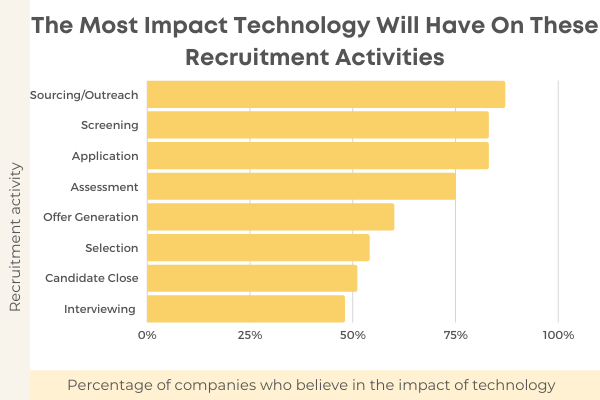

36. In the US, 80% of small businesses use or plan to use HR software in the next couple of years.
When it comes to HR technologies, HR software is in common practice in the US, according to Zippia. Namely, 80% of small businesses are already using or planning to use HR software in the next couple of years.
Source: Zippia
37. Three in four recruiters use applicant tracking software to find talent, 79% use social media.
According to Paycor, recruiters majorly use technology when looking for talent. Out of different technologies available for finding talent, 75% of recruiters use applicant tracking software for it, while 79% use social media.
Source: Paycor
38. Three-quarters of all companies are already using the cloud.
According to Denodo and their Global Cloud Survey 2020, 75% of companies use the cloud. The data comes from a survey of 250 organizations. This means that the large majority of them have already implemented workloads in the cloud, at least one.
Source: Denodo
39. Almost nine in 10 companies (89%) used an annual survey in 2015.
While 89% of companies used an annual survey in 2015, this number went down to 74% in 2019. Annual surveys are used by these companies to determine how their employees are feeling, either at the end of the year, or any other time of the year.
Source: Gartner
40. Four in 10 companies say their success in HR software is closely connected to the IT department working with HR.
Around 41% of companies say they owe their success in HR software to the fact that their HR department has a close relationship with the IT department. In other words, to be able to implement an HR software application, both HR and IT need to work together.
Source: Gartner
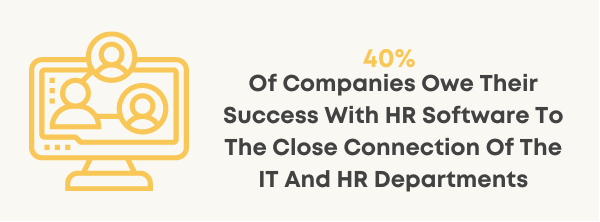

HR Statistics UK
41. In the UK, HR provision is estimated to fall by 6.6% in 2020-2021.
Due to the ongoing COVID-19 pandemic, HR provision in the UK was expected to fall by 6.6% in 2020-2021. Moreover, in 2021, this provision is estimated to be partially recovered by 3.3%.
Source: IBIS World
42. From 2021 to 2022, the HR industry revenue in the UK is expected to reach £1 billion.
According to IBIS World, the HR industry is expected to reach a revenue of £1 billion in the UK. That is an increase at a compound rate of 3.4% over the five years from 2016 to 2021.
Source: IBIS World
43. In the UK, the HR market size is valued at £978 million.
At the moment, the size of the HR market is valued at £978 million and it is expected to reach £1 billion in the next year or so, according to the HR statistics UK data.
Source: IBIS World


44. Since 1995, the sickness absence is the lowest in 2021.
According to the UK’s Office for National Statistics, the sickness absence in 2021 is the lowest since 1995. The sickness absence reported in March 2021 was only 1.8%. It could be because so many people were working from home due to the pandemic.
Source: Office for National Statistics
45. Eight in 10 UK companies report they have the needed information for their HR and personnel costs.
While four-fifths (or 80%) of UK companies say they have insights into their HR and personnel costs, this is not so evident in other European countries. For instance, 26% of European organizations said they have little to no insight into this type of data. Furthermore, in France, this share is 44%.
Source: SD Worx
Other Interesting Human Resources Statistics
46. 75% of employers reject candidate applications due to bad grammar and typos.
Three in four employers (75%) agree they reject candidates who show bad grammar and typos in their applications. This is according to an OfficeNeedle study that surveyed 2800 employers around the globe.
Source: OfficeNeedle
47. More than half of employers (57%) might reject a resume that is longer than two pages.
More than one in two employers (57%) who were asked about the length of the resume, said they would reject a resume that is longer than two pages. In contrast, CVs can have longer formats.
Source: OfficeNeedle
48. Almost 50% of employers do not take resumes that are not tailored to the position into consideration.
According to the OfficeNeedle report from 2021 on CV and resume mistakes, almost one in two (47%) of employers agree that they would not take into consideration resumes that are not tailored to the position the candidate is applying for.
Source: OfficeNeedle
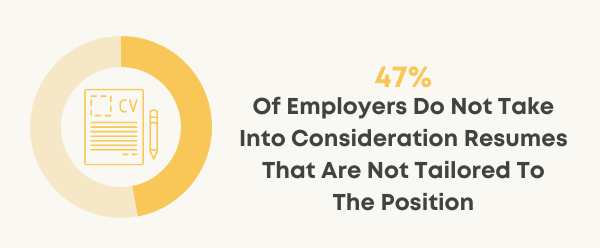

49. Only 18% of employers want to see reasons for gaps in the resume.
While some may think it is a good idea to put reasons for gaps in the resume, according to OfficeNeedle, only 18% of employers want candidates to explain those gaps in the resume. However, it may be necessary to explain those gaps in an interview or a cover letter.
Source: OfficeNeedle
50. Under 1 in 10 employers think it is a mistake to omit including the GPA in the resume.
When it comes to other CV and resume mistakes, only 7% of employers who hire talent say it is a mistake to omit including the GPA in the resume. Also, 43% of employers say that not including accomplishments is a mistake.
Source: OfficeNeedle
51. Recruiters spend only five to 10 seconds reviewing a resume.
When they review candidates’ applications, recruiters do not tend to spend more than five to ten seconds reviewing a resume, according to a Glassdoor survey from 2020. As candidates do not have a lot of time to leave an impression, they have to make sure their resume stands out from the rest.
Source: Glassdoor
Final Verdict
In conclusion, HR statistics show us the state of the industry at the moment, in comparison with the past and estimations for the future. Moreover, HR data and statistics also tell us how important is it to keep up with the trends to be able to attract and retain talent. Also, if HR leaders want to improve continuously, they need to know what drives their decisions. Finally, with the help of statistics, it is easier to learn what will motivate employees and how companies can help them become more productive. Human resources industry statistics and human resource management statistics are also important to keep in mind.


































Find Us on Socials